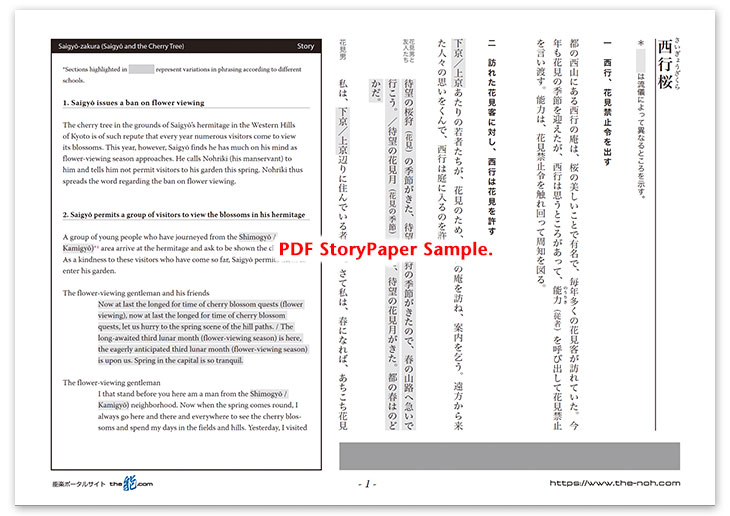
 Saigyō-zakura (Saigyō and the Cherry Tree)
Saigyō-zakura (Saigyō and the Cherry Tree)

![]()
The cherry tree in the grounds of Saigyō’s hermitage in the Western Hills of Kyoto, is renowned for the beauty of its blossoms. Every year, visitors come to see the famous cherry blossoms and the grounds of the hermitage throng with people, but the hermit Saigyō is unhappy about the disruption to the peaceful tranquility of his secluded existence, and orders Nohriki (his manservant) not to permit visitors to the cherry tree in his garden this spring. Nevertheless, visitors – unaware of Saigyō’s edict, perhaps – journey from the capital to the view the blossoms and ask to be shown into the grounds. Unable to refuse their request outright, Saigyō gives the visitors permission to enter the garden. The conviction that the peaceful atmosphere of the garden is about to be shattered prompts Saigyō to composes a poem: “To see the flowers is the reason I am told why people flock here. Hardly fitting, but the fault lies with the wretched cherry tree.” (The cherry tree, he says, is guilty for drawing flocks of people to enjoy the beauty of the flowers.)
That evening, while Saigyō is resting under the cherry tree, an old man appears to him in a dream. The old man remonstrates with Saigyō about his poem, telling him that since trees and plants are insentient the blossoms must be innocent. Saigyō concedes the point and, addressing the old man, says that only the spirit of the blossoms could reason thus. The old man reveals that he is the spirit of the ancient cherry tree and tells Saigyō that whilst the blossoms may be silent, he feels obliged to defend their innocence. The spirit of the cherry tree expresses his delight at making Saigyō’s acquaintance, enumerates the locations in the capital that are famous for their cherry blossoms and then dances whilst lamenting the fact that a moment of time on a spring evening is as precious as a thousand pieces of gold.
Time passes and, as the shadows of the blossoms reveal the approaching dawn, Saigyō awakens from his dream and the spirit of the cherry tree vanishes quietly without a trace amidst the scattering petals of the tree.
![]()
As the play opens, a covered wooden frame shaped like a mountain and adorned with a branch of flowering cherry is brought onto the stage. This structure in fact conceals the shite (lead actor), who remains hidden whilst the waki (supporting actor), waki-tsure (the actors accompanying the waki) and ai (attendant) make their entrance, thereby creating the daytime story of the first half. Later in the production, as night approaches, the other actors exit leaving only the sleeping waki on stage; the cloth is removed, the shite appears to the waki in a dream, and the two actors converse. The lively opening draws the audience seamlessly into the play, allowing them to feel that they are viewing the cherry blossoms with the actors and, unconsciously, to enter Saigyō’s dream where they encounter the spirit of the cherry tree.
The human qualities of the seemingly insentient spirit of the cherry tree as it disagrees with the words of the poem, converses pleasurably with Saigyō and makes merry with dance, also make for fascinating viewing. This ability of the spirit of trees and plants to become protagonists is not limited to this play, but is has undercurrents of the teachings of Japanese Buddhism* that says “All living beings alike possess the Buddha nature” (i.e. all beings, including insentient beings such as trees and plants, have the potential to attain enlightenment). In Buddhism, trees and plants (vegetation) are essentially perceived as insentient (unfeeling) beings, and their ability to attain nirvana was not recognized in Early Buddhism in India. With the arrival of Buddhism in China and Japan, however, the concept of the Buddha nature in unfeeling (insentient) beings and of their potential to attain enlightenment took root.
In “Saigyō and the Cherry Tree”, the dignified and invigorating figure of the spirit of the cherry tree is particularly stirring and impressive. Put the melancholy world behind you and enjoy this elegant encounter.
* Current research confirms that this term first appears in a book written by Annen, a scholar of the Tendai sect of Mt. Hiei in the middle of the Heian period.
STORY PAPER : Saigyō-zakura (Saigyō and the Cherry Tree)
Story Paper presents noh chant stories in modern speech, with story outlines, highlights and more using Adobe PDF format, which can print out and zoom in. Print out the pages and take them with you when you see the actual noh performance.

The copyright of Story Paper is held by the Noh.com. Story Paper is for individual use only. It is prohibited by the copyright law to distribute or publish printed-out Story Paper pages without prior consent. For more information, check the credit and disclaimer pages.



 [Saigyō-zakura (Saigyō and the Cherry Tree) : Story Paper PDF : 511KB
[Saigyō-zakura (Saigyō and the Cherry Tree) : Story Paper PDF : 511KB